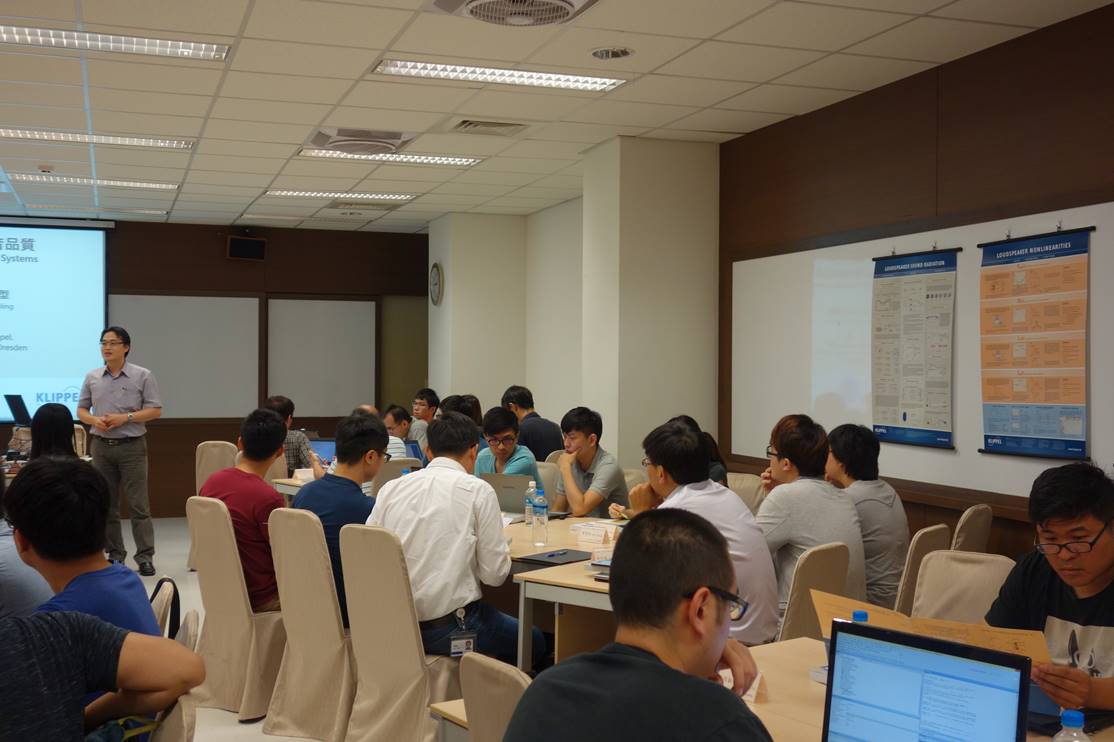【研討會】Sound Quality of Audio Systems 揚聲器系統的品質控制
主 題:Sound Quality of Audio Systems 揚聲器系統的品質控制
主 講: Dr. Wolfgang Klippel 科力普博士
會議日期:2015/07/01~07/03
會議地點:逢甲大學育成中心
會議費用: 產業同仁報名費:新台幣 6,000元 進修生或在學生報名費:新台幣 1,000元
對象
- 電聲系統工程設計開發、品質管理工程設計相關- 機械電聲工程相關學系學生
主辦單位:尚馬電聲科技有限公司
協辦單位:逢甲大學電聲碩士學位學程、電聲產學技術發展與驗證聯盟
摘要
本次課程主要著重於如何利用硬體量測設備與感知方式來評估揚聲器系統。課程中將利用集中參數與分佈參數系統所建立的線性、非線性與時變的分析系統,針對訊號上所產生的失真進行模擬。在測試訊號上,本量測系統除了可使用標準的測試訊號外,也可採用音樂訊號進行。本課程將完整的說明系統失真所產生的徵兆與背後的物理成因,亦將探討利用物理方法結合聽測與聆聽技巧所獲得聽感上的聲音品質影響。這些專業知識對於將採用低成品的換能器與新的控制技術(智慧型放大器)來達到具有高效率與高聲音品質的微型、質輕以及其他相關聲音產品的設計與製作上來說是相當重要的。本次新議題
如何使用電子控制的方式主動地來保護揚聲器,避免造成太大的機械變形與產生太高的溫度 如何針對特定的傳感器來完成此主動保護系統的調整
如何定義微型揚聲器的最大峰值位移
如何找出搖擺模態的主要原因
如何在非無響的環境中量測低頻在遠場的響應
如何評估個人音頻設備3D的輸出
Abstract:
The lecture addresses the evaluation of sound reproduction systems using physical and perceptive measurement techniques. The generation of signal distortion is modeled by linear, nonlinear and time-variant systems with lumped and distributed parameters. New measurement techniques based on those models are presented using test signals and music as well. The course makes the relationship between symptoms and physical causes of the distortion more transparent and discusses the impact on the perceived sound quality by combining listening tests, auralization techniques with physical methods. This knowledge is important for designing and manufacturing small, light and reproducing the sound at high efficiency and sufficient sound quality using cost-effective transducers and new control techniques (smart amplifiers).New topics addressed this year:
How to use electric control for protecting loudspeakers actively against mechanical and thermal overload? How to adjust an active protection system to the particular transducer?
How to specify maximum peak displacement of a microspeaker ?
How to find the root cause of rocking modes?
How to measure far field response at low frequencies in a non-anechoic environment?
How to assess the 3D output of personal audio devices?
Content 會議內容
Electro-acoustical Modelling電聲模組 Fundamentals - transduction, vibration, radiation基礎 – 換能、振動、輻射
Abstraction - models with lumped and distributed parameters理論部分 – 集中和分佈參數模型
Small Signal Performance - linear approximation and transfer function小信號特性 – 線性近似及轉換函數
Large Signal Performance - thermal dynamics and nonlinearities大信號特性 – 熱力學和非線性
Time-varying properties - influence of climate and aging隨時間變化的特性 – 氣候和老化的影響
Measurements and Analysis測量與分析
Persistent excitation - artificial and natural stimuli連續激發型態 - 人為和自然激發訊號 Monitored signals - electrical, mechanical and acoustical sensors監控訊號 – 電子、機械和聲學感測器
Complex structures - digital and analogue components複雜的結構 – 數位和類比元件
Sound field - measurements in the near and far field聲場 – 近場與遠場的測量
Interaction with the room - direct and diffuse sound part空間內的相互作用 – 直接音與散射音
Measurement time - ultra-fast and long-term (power) testing測量時間 – 超快速的測量與長時間(功率)測試
Distortion analysis - linear and nonlinear components失真分析 – 線性和非線性元件
System identification - optimal fitting and parameter estimation系統識別 – 最佳化近似及參數預測
Transformations - Fourier, wavelet and perceptual modelling轉換 – 傅立葉、小波和聽感模擬
Data compression - separation of unique and redundant information資料壓縮 – 分離有效及無效的資料
Interpretation and Diagnostics分析與判斷
Interpretation - measured symptoms and physical causes解析 – 量測獲得的徵兆與相對的物理成因
Perception - audibility and impact on perceived sound quality感知 – 在感知聲音品質的清晰度與影響
Evaluation - selection of optimal drive units for system design評價 - 對於系統設計來說最佳驅動裝置的選擇
Specification - minimal but comprehensive set of data誤差 – 參數和影響力的變化
Selection of issues addressed in the practical workshop特選範例討論
How to get maximal power handling and acoustical output?如何獲得最大的耐功率和聲壓的輸出? Which loudspeaker nonlinearities are good and which are bad?如何分辨揚聲器之非線性的好壞?
How to interpret the results of distortion measurements?如何解釋失真度測量的結果?
How to perform proper acoustical measurements without anechoic room?如何在非無響室的環境下完成聲學測量?
How to get valid material parameters as input for FEA?如何獲得有限元素分析所需的有效參數?
How to find the optimal geometry of the cone?如何找到最佳鼓紙幾何設計形狀?
How to design loudspeaker enclosures with BEA?如何使用邊界元素分析來設計揚聲器音箱?
How to detect air leaks in enclosures?如何檢測音箱的漏氣?
How to reduce the rejection rate in manufacturing?如何降低生產上所造成不良率?
How to cope with ambient noise corrupting the measurement?如何應對環境噪音對測量的影響?
歡迎各位將電聲研發工作中的特別疑問或是其他有興趣討論的題材發送給Emma Yu/尚馬電聲 (emma.yu@somaacoustic.com.tw),我們將提議給科力普博士併入於此次研討會中一起分析及討論。
Prof. Klippel will address other topics in his lecture which are important for your work. Please send your wish list or detaled question to emma.yu@somaacoustic.com.tw.
報名截止日:2015/06/22
報名網址
http://www.somaacoustic.com.tw/brand_discussion_detail.php?dicsussionid=24look more event photos



